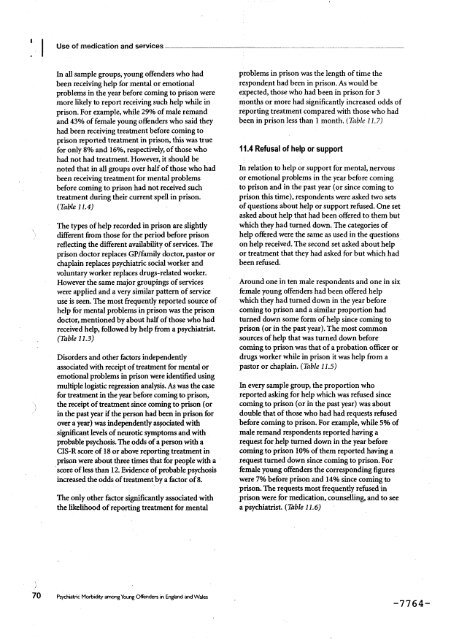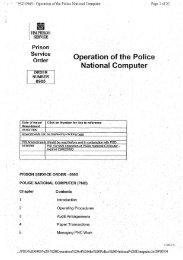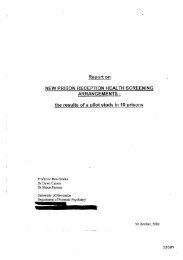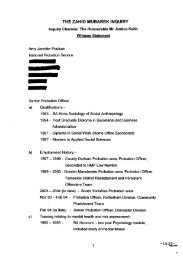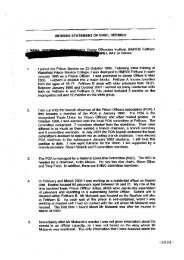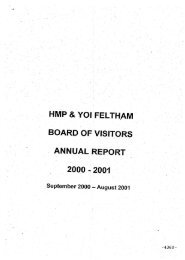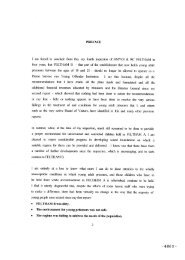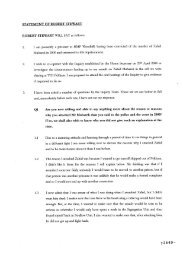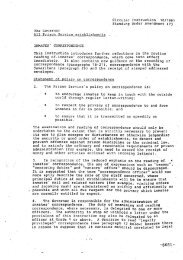Neurotic disorders
Neurotic disorders
Neurotic disorders
You also want an ePaper? Increase the reach of your titles
YUMPU automatically turns print PDFs into web optimized ePapers that Google loves.
I I Use of medication and services ............ .............................................................................................<br />
In all sample groups, young offenders who had problems in prison was the length of time the<br />
been receiving help for mental or emotional respondent had been in prison. As would be<br />
problems in the year before coming to prison were expected, those who had been in prison for 3<br />
more likely to report receiving such help while in months or more had significantly increased odds of<br />
prison. For example, while 29% of male remand reporting treatment compared with those who had<br />
and 43% of female young offenders who said they been in prison less than 1 month. (Thble I 1.7)<br />
had been receiving treatment before coming to<br />
prison reported treatment in prison, this was true<br />
for only 80/0and 16O/o,respectively, of those who 1t.4 Refusal of helpor support<br />
had not had treatment. However, it should be i<br />
noted that in all groups over half of those who had In relation to help or support for mental, nervous<br />
been receiving treatment for mental problems or emotional problems in the year before coming<br />
before coming to prison had not received such<br />
to prison and in the past year (or since coming to<br />
treatment during their current spell in prison, prison this time), respondents were asked two sets<br />
(Table 11.4) of questions about help or support refused. One set<br />
asked about help that had been offered to them but<br />
The types of help recorded in prison are slightly which they had turned down. The categories of<br />
_ different from those for the period before prison help offered were the same as used in the questions<br />
reflecting the different availability of services. The on help received. The second set asked about help<br />
prison doctor replaces GP/family doctor, pastor or or treatment that they had asked for but which had<br />
chaplain replaces psychiatric social worker and been refused.<br />
voluntary worker replaces drugs-related worker.<br />
However the same major groupings of services Around one in ten male respondents and one in six<br />
were applied and a very similar pattern of service female young offenders had been offered help<br />
use is seen. The most frequently reported source of which they had turned down in the year before<br />
help for mental problems in prison was the prison coming to prison and a similar proportion had<br />
doctor, mentioned by about half of those who had turned down some form of help since coming to<br />
received help, followed by help from a psychiatrist, prison (or in the past year). The most common<br />
(Table 11.3) sources of help that was turned down before<br />
cOming to prison was that of a probation officer or<br />
Disorders and other factors independently drugs worker while in prison it was help from a<br />
associated with receipt of treatment for mental or pastor or chaplain. (Table 11.5)<br />
emotional problems in prison were identified using<br />
multiple logistic regression analysis. As was the case In every sample group, the proportion who<br />
for treatment in the year before coming to prison, reported asking for help which was refused since<br />
_ the receipt of treatment since coming to prison (or coming to prison (or in the past year) was about<br />
•: in the past year if the person had been in prison for double that of those who had had requests refused<br />
over a year) was independently as_iated with before coming to prison. For example, while 5% of<br />
significant levels of neurotic symptoms and with male remand respondents reported having a<br />
probable psychosis. The odds of a person with a<br />
request for help turned down in the year before<br />
CIS-R score of 18 or above reporting treatment in coming to prison 10% of them reported having a<br />
prison were about three times that for people with a request turned down since coming to prison. For<br />
score of less than 12. Evidence of probable psychosis female young offenders the corresponding figures<br />
increased the odds of treatment by a factor of 8. were 7% before prison and 14% since coming to<br />
prison. The requests most frequently refused in<br />
The only other factor significantly associated with prison were for medication, counselling, and to see<br />
the likelihood of reporting treatment for mental a psychiatrist. (Table 11.6)<br />
)<br />
70 PsychiatricMorbidityamong YoungOffendersin EnglandandWales<br />
-7764-


